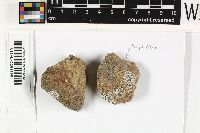
Consortium of Lichen Herbaria
- building a Global Consortium of Bryophytes and Lichens as keystones of cryptobiotic communities -
- Home
- Search
- Images
- Species Checklists
- US States: O-Z >
- US National Parks
- Central America
- South America
- US National Parks
- Southern Subpolar Region
|
|
|
|
Family: Caliciaceae
|
Nash, T.H., Ryan, B.D., Gries, C., Bungartz, F., (eds.) 2007. Lichen Flora of the Greater Sonoran Desert Region. Vol 3. Thallus: crustose, areolate, thin to moderately thick, ±dispersed; prothallus: conspicuous black, strongly developed, usually between the areoles (forming a hypothallus) as well as surrounding the thallus outline surface: usually white to whitish gray, rarely beige, dull, epruinose, phenocorticate, esorediate medulla: white, lacking calcium oxalate (H2SO4-) Apothecia: lecideine; (0.2-)0.3-0.6(-1.1) mm in diam., circular often becoming ±angular, remaining immersed, not becoming sessile (but disc sometimes convex and emerging from the surface) margin: black (or color masked by grayish remains of necrotic thalline material, thalline veil), indistinct, reduced, inconspicuous disc: black, epruinose, plane, often becoming strongly convex with age proper exciple: narrow, poorly differentiated, aethalea-type, inner excipular hyphae narrow, hyaline, prosoplectenchymatous (textura oblita), often reduced, similar in structure and orientation to the paraphyses, transient with the hyaline subhymenium and the brown hypothecium (leptoclinoides-brown, textura intricata), outer excipular hyphae parallel, moderately swollen (textura oblita) and usually strongly carbonized with various amounts of brown and aeruginose pigments (cf. elachista-brown and cinereorufa-green, HNO3+ violet) epihymenium: brown, pigmentation continuous with the outer exciple (HNO3-) hymenium: hyaline, not inspersed with oil droplets; paraphyses: simple to moderately branched, apically swollen, with a brown pigment cap (cf. elachista-brown) asci: clavate, Bacidia-type, 8-spored ascospores: soon brown, 1-septate, oblong to ellipsoid, usually not constricted, with obtuse ends, not curved, (12-)13.5-[15.1]-16.7(-20) x (6-)6.2-[7]-7.9(-9) µm (n=60); proper septum: becomes distinctly thickened during spore ontogeny (Physconiatype); ornamentation: rugulate Pycnidia: rare, urceolate to globose, unilocular; ontogeny similar to the Umbilicaria-type conidiogenous cells: mostly terminal, rarely also intercalary (cf. conidiophore-type V) conidia: bacilliform, 2.5-4.5 x 1.5-2 µm (n=20) Spot tests: usually thallus and medulla K+ yellow to red (crystals), P+ yellow, C- (rarely C+ pink), KC- (rarely KC+ pink), CK- fluorescence: UV+ pale ivory (if gyrophoric acid present) iodine reaction: thallus amyloid (medulla strongly reacting, even if tested directly on the cortex) Secondary metabolites: atranorin, norstictic with connorstictic acid, and gyrophoric acid (J.A. Elix, HPLC). Substrate and ecology: epilithic, on a variety of siliceous (HCl-) rock substrates, in montane to subalpine habitats World distribution: only known from western North America Sonoran distribution: widely scattered in the mountains of Arizona and Sonora, also one collection from top of San Pedro Martir (Baja California). Notes: Imshaug (1951) suggested that B. lacteoidea could be reliably distinguished from B. spuria because of its hyaline hypothecium. The hypothecium is, however, pigmented in both species. Buellia lacteoidea has a distinct subhymenium, i.e., a hyaline layer of ascogeneous hyphae between the hymenium and the hypothecium. In contrast, the subhymenium of B. spuria is pigmented and thus can hardly be distinguished from the hypothecium below. The two species can also be distinguished by their spores: those of B. lacteoidea have a distinct septal thickening not observed in B. spuria. |
Powered by Symbiota






















